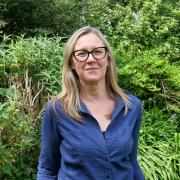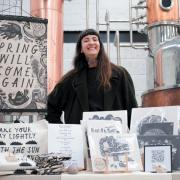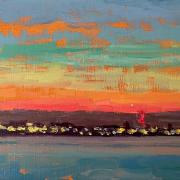Slowly turning some of Southampton’s vacant historical and commercial spaces in to workshops and galleries, ASpaceArts is providing a future for the city’s up and coming artists says Sandra Smith
From Grade I listed landmarks, the solidity of Italianate designs, ancient monuments and waterfront creations whose shape and fusion of materials ooze state of the art, Southampton’s buildings both reflect a colourful history and confirm its status as a metropolis embracing modern trends.
Such breadth of styles and ages reflects a refusal by society or the workplace to remain static. The city’s progress is as welcome as it is necessary with residents profiting as the beneficiaries. Yet evolution is often matched by the inevitability of abandonment for how soon neglect surfaces once a building outgrows its underlying purpose or the original function simply dies out.
ASpaceArts, however, has devised an alternate option. By reinventing discarded buildings, this organisation not only ensures that artists starting up their own businesses benefit from renting affordable units, they are simultaneously reviving Southampton’s heritage.
Studio Manager, Ria Loveridge, explains their origins: “When our Director, Daniel Crow, graduated from Southampton University after doing a Fine Art and Illustration degree he found a lack of artist space in the city. In the old part of town he set up Northam Road Gallery for himself and a couple of graduates.”
The vision behind the enterprise is as simple as it is logical. Empty buildings are uneconomical for Councils, whilst artists need space in which to practise and create. Merging the two seemed obvious and became the root behind changing the city’s cultural landscape.
“When we moved into The Arches under a big Victorian bridge,” Ria continues, “we made seven pods. It used to be an old cattle market but we have now developed four arches which support 21 artists. Each studio has its own genre and the breadth is massive. Currently at this venue we have a traditional flute maker, painters, ceramicists and conceptual performance artists.”
One of the artists here is Solent graduate and screen printer, Ryan Ward, who first learned of ASpaceArts during his time at university.
“When I was studying at Solent, Dan from ASpaceArts came to talk about options after leaving university. I contacted him when I finished my course five years ago, applied, and there was a suitable space straight away. It was the smallest space. At the time I was trying my hand at being a freelance illustrator but it was hard to get your foot in the door. I’d done a project based on traditional printing at university and had an old second hand screen printing press. A technician I knew said printing tee shirts was a lucrative business. Since then I’ve progressed and bought equipment so partition walls have been taken down to create a bigger studio.”
Ryan is grateful for this workspace and also benefits from ongoing advice.
“I have a meeting with Dan and Ria every couple of months to discuss things like business plans. They also send out emails telling us about opportunities such as having work displayed in galleries.”
With customers including clothing retailers, bands and a wrestling promoter, Ryan’s business continues to flourish. Relishing a working environment in which he mixes with likeminded, creative people he is planning to engage an intern this year.
The old Sorting Office in Eastleigh similarly houses a diverse range of creatives such as jewellery maker, Joanne Tinley, who is appreciative of having her own studio in return for a modest rent.
“The boost to my confidence in being able to give a studio rather than a home address has been huge. I moved in two years ago and wouldn’t have got this far this soon without ASpaceArts. I had looked at the cost of a small industrial unit but this is definitely more economical. They offer business development too and I was able to successfully apply for extra funding, which covered half the costs for my first trade show. Also, the support from other residents is fantastic - there’s great camaraderie between us all.”
The outside of this somewhat sterile looking 1920s building has been softened with flowers. The interior is bright, colourful and warm.
“My studio is on the ground floor,” Joanne continues. “Our postmen who used to work here are fascinated by it - one of them believes my room is where telegrams came in and out. Clients who attend meetings all comment on the fantastic atmosphere.”
The process of applying for units in any of the venues is a formal one. A waiting list for each venue demands that, when a studio becomes available, applications are reviewed and interviews with artists appropriate for the space take place. Once an artist is in situ, assistance continues via annual reviews when Ria covers achievements, progress and forthcoming plans. All inclusive rents for these studios include heating and broadband. In addition, extra spaces are available to hire for exhibitions. Open days. held once a year, are part of the lease agreement, such events creating a forum for the public to engage with artists’ work.
Another ASpaceArts structure to have been recycled is Tower house. Originally stables and attached to the sixteenth century Godshouse Tower at the south east corner of the city walls, Tower House is home to Massive Monster, an award winning games company.
“We are the only game developing company in Southampton,” Jay Armstrong tells me. “Mike Tucker and I set up the company a year and a half ago and moved here quite quickly. We asked for this venue because it positions itself to be slightly more techy. Our studio is a large, bright room full of computers and houses a huge library of video games. It’s very casual with lots of plants and an old fashioned style arcade machine I built.
The subsidised rent has been good for us and we have enough room to bring in students from Solent, where Mike lectures. The idea is that you’re not here forever. As soon as we can we will give someone else an opportunity.”
Over 50 artists rent studio space from ASpaceArts. They are immune from pressure of production since the charity recognises the value of experimentation in the early stages of an artistic career. Most artists are local to their studios and are keen to interact with the neighbouring community and businesses.
Turning Godshouse Tower into an arts and heritage centre is the charity’s main focus at present. The project, likely to cost £2.4m, will engage with the city collection and provide space for music, exhibitions, retail and café. Funding from the Arts Council, along with help from the Lottery and Creative Network South is crucial to this ongoing work.
Although artists aren’t restricted regarding how long they may stay in a studio, there is an unwritten expectation that businesses will eventually outgrow their space and move on, making way for new businesses to use the space. Meanwhile the pioneering attitude of ASpaceArts continues to nurture promising artists, providing them with freedom from onerous financial pressures and sufficient time and space to develop skills, knowledge and customers - thereby contributing not only to individual careers but also to the economic and cultural heart of Hampshire’s largest city.
Find out more
Find out more about the charity at www.aspacearts.org.uk. For more information on our featured artists, visit: www.joannetinleyjewellery.com, www.massivemonster.co.uk and www.facebook.com/handsonprinting
READ ON
• The artisan producer restoring Portsmouth’s soap making tradition - Portsmouth has a famous naval heritage but did you know that it once had a thriving soap making industry too? Viv Micklefield scrubs-up to meet the local woman who’s bringing back a touch of nostalgia to these shores
• Ian Brown: Fordingbridge farmer to hit songwriter - With his knees deep in mud on the farm, Ian Brown received a call that would change his life forever. Peter White hears how he went from humble farmer to hit songwriter when they met in Fordingbridge



























